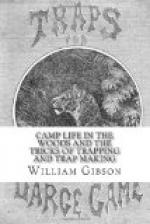It should be made about the size of a lead pencil, and eleven [Page 92] inches or so in length, depending of course upon the size of the box.
It should then be divided in two pieces by a perfectly flat cut, the longer part being six inches in length. This piece should be attached to the back board of the box by a small string and a tack, as shown at (c), its end being bluntly pointed. Its attachment should be about five inches above the bottom board, and in the exact centre of the width of the back.
[Illustration]
Near the flat end of the other piece the bait consisting of a berry or other fruit, should be secured, and the further extremity of the stick should then be rounded to a blunt point. The trap is now easily set. Raise the lid and lift the long stick to the position given in the illustration. Adjust the flat end of the bait stick against that of the former, and allow the pressure of the lid to bear against the blunt point of the short stick at (d), as shown in the illustration, a straight dent being made in the cover to receive it, as also in the hack of the box for the other piece. If properly constructed, this pressure will be sufficient to hold the sticks end to end, as our engraving represents, and the trap is [Page 93] thus set. The slightest weight on the false perch thus made will throw the parts asunder, and the cover closes with a snap.
The greatest difficulties in constructing the trap will be found in the bearings of the bait sticks (b), the ends of which must be perfectly flat and join snugly, in order to hold themselves together. The box may now be suspended in a tree by the aid of a string at the top. The first bird that makes bold enough to alight on the perch is a sure captive, and is secured without harm. If desired, the elastic may be attached to the inside of the cover, extending to the back of the box, as seen in the initial at the head of this chapter. If the elastic in any event shows tendencies toward relaxing, the tin catch described on page 88 should be adjusted to the lower edge of the box to insure capture.
THE HAWK TRAP.
[Illustration]
Our illustration represents a hawk in a sad plight. The memory of a recent feast has attracted it to the scene of many of [Page 94] its depredations: but the ingenious farmer has at last outwitted his feathered foe and brought its sanguinary exploits to a timely end. This trap is a “Yankee” invention and has been used with great success in many instances where the hawk has become a scourge to the poultry yard. The contrivance is clearly shown in an illustration, consisting merely of a piece of plank two feet square, set with stiff perpendicular pointed wires.
This affair was set on the ground in a conspicuous place, the board covered with grass, and the nice fat Poland hen which was tied to the centre proved a morsel too tempting for the hawk to resist. Hence the “fell swoop” and the fatal consequences depicted in our illustration. The owl has also been successfully captured by the same device.




